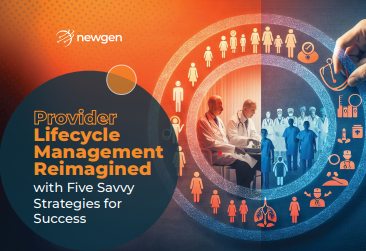The PLM Challenge in Healthcare
Healthcare payers face immense pressure to manage providers efficiently, meet compliance standards, and maintain accurate, real-time data. Yet, outdated and disconnected systems, manual processes, and frequent regulatory changes continue to hold them back.
An inefficient Provider Lifecycle Management (PLM) system can lead to lost revenue, compliance violations, and provider dissatisfaction. This eBook outlines five transformative strategies that help healthcare organizations modernize their PLM ecosystem, reduce administrative burdens, and deliver better provider experiences.
The Modernization Imperative
Before diving into transformation, ask yourself:
- Does your PLM system ensure real-time compliance tracking?
- Can it streamline provider onboarding and reduce administrative bottlenecks?
- Is it agile enough to respond to evolving industry changes?
- Can it integrate seamlessly with other enterprise systems?
If the answer is no, your PLM platform may be limiting your organization’s efficiency and growth. In today’s competitive healthcare environment, speed and accuracy are the cornerstones of success.
Common Barriers in Provider Lifecycle Management
Many health plans face similar challenges that slow them down:
- Lack of Visibility: Fragmented systems make it difficult to track onboarding, credentialing, and contracting processes.
- Communication Breakdowns: Siloed tools prevent teams from collaborating effectively.
- Inefficient Engagement: Manual onboarding and inconsistent data create friction for providers.
- Claims Inefficiency: Inaccurate claims handling leads to disputes, lower ratings, and higher administrative costs.
- Audit Challenges: Disorganized documentation complicates regulatory audits.
- Compliance Risks: Outdated provider directories and manual updates increase regulatory exposure.
These issues drain resources, affect provider trust, and limit scalability. However, a modern, automated PLM can turn these pain points into opportunities for efficiency and growth.
Five Key Strategies to Transform Your PLM
1. Adopt a Strategic, Provider-Centric PLM Approach
Traditional PLM systems focus primarily on transactions — onboarding, credentialing, and compliance. A modern approach prioritizes data-driven decision-making, integration, and provider experience.
Strategic focus areas include:
- Provider-centric frameworks for collaboration and transparency.
- Data-driven analytics to identify trends and optimize operations.
- Integrated workflows for end-to-end lifecycle management.
This shift ensures that PLM becomes a growth enabler, not just an administrative function.
2. Build a Digital-First, Agile Foundation
Digitization and agility are at the heart of a scalable PLM system. Low-code platforms empower healthcare organizations to quickly build custom applications and automate repetitive tasks without heavy IT dependency.
Transformative impact:
- Faster onboarding: Automate credentialing workflows to reduce manual data entry and processing delays.
- Simpler compliance management: Quickly adapt to changing regulations without major system overhauls.
- Robust data integration: Seamlessly connect PLM with core systems for real-time data access and updates.
Low-code solutions ensure agility, adaptability, and faster go-to-market capabilities.
3. Implement Business Process Management (BPM) for Structured Workflows
BPM introduces a systematic, rules-based framework to streamline provider management workflows. It enhances operational efficiency and supports continuous process improvement.
Benefits include:
- Automated onboarding: Minimize manual effort through AI-driven workflow orchestration.
- Real-time monitoring: Track provider performance, compliance, and credentialing in real time.
- Compliance assurance: Ensure regulatory adherence with automated tracking and audit trails.
McKinsey reports that automation can reduce administrative workload in healthcare by up to 70 percent, freeing teams to focus on value-added tasks.
4. Create an End-to-End Provider Journey
A successful provider relationship depends on consistency, transparency, and collaboration throughout the entire lifecycle. A well-structured end-to-end provider journey ensures that every interaction — from onboarding to performance evaluation — is efficient and frictionless.
Core benefits:
- Unified communication channels for faster, more transparent engagement.
- Integrated data management for accuracy across onboarding, contracting, and claims systems.
- Continuous support mechanisms such as self-service portals and helpdesks to empower providers.
When provider journeys are seamless, organizations achieve stronger partnerships and higher satisfaction scores.
5. Strengthen Data Integrity with Provider Data Management (PDM)
Accurate provider data is the foundation of every efficient PLM system. A strong PDM framework ensures that information is validated, updated, and securely accessible.
Key benefits:
- Automated validation: Reduce data errors and compliance risks.
- Centralized access: Ensure all teams access consistent, reliable provider information.
- Smarter analytics: Leverage insights to assess network adequacy and performance.
According to McKinsey, nearly $1 trillion in U.S. healthcare spending is wasted annually due to data inefficiencies. Effective PDM can cut this waste by 50 to 75 percent.
Unified Solutions and Seamless Integrations
Healthcare organizations need interoperable systems to ensure compliance and scalability. The Centers for Medicare & Medicaid Services (CMS) mandates the use of FHIR-based APIs to improve electronic data exchange.
Impact of unified PLM integration:
- Real-time data exchange across applications like CAQH, NPPES, and Medicaid state files.
- Error-free data updates and streamlined IT operations.
- Better decision-making through integrated insights.
Unified PLM systems minimize redundancies, enhance accuracy, and drive proactive governance.
How Newgen Helps You Modernize PLM?
Newgen’s Provider Lifecycle Management Solution, built on the NewgenONE AI-powered low-code platform, enables payers to automate, connect, and optimize every aspect of provider management.
Key capabilities include:
- End-to-end automation across credentialing, contracting, and maintenance.
- AI-enabled compliance tracking and provider data management.
- Seamless integrations with existing core and peripheral systems.
- Configurable workflows aligned with CMS and NCQA standards.
- Role-based dashboards and analytics for complete visibility.
With over 20 years of experience in healthcare, Newgen helps payers streamline PLM operations for faster onboarding, reduced compliance risk, and higher provider satisfaction.
The Future of PLM
Healthcare payers that modernize PLM systems today will gain a significant competitive advantage tomorrow. The path forward lies in leveraging low-code platforms, intelligent automation, and unified data management to ensure accuracy, speed, and compliance.
A reimagined PLM not only drives operational excellence but also builds a more connected, efficient, and provider-focused healthcare ecosystem.
Start Your Transformation Today
Modernize your provider management with Newgen’s AI-enabled, low-code PLM Solution. Simplify workflows, enhance compliance, and deliver exceptional provider experiences with a unified, intelligent platform.

